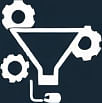Optimizing Automation Workflow Design in Revenue Operations
 by Max Miller
by Max Miller
Automation workflow design plays a crucial role in enhancing revenue operations by streamlining processes and boosting efficiency. This article explores key strategies for creating effective workflows that support sales and operations teams, leading to improved performance and cost savings.

Automation workflow design is essential for modern businesses aiming to improve their revenue operations. By focusing on this area, organizations can achieve greater efficiency in their daily tasks. For instance, automation helps reduce manual errors and speeds up processes that were once time-consuming.
In revenue operations, the core goal is to align sales, marketing, and customer service efforts. Effective workflow design ensures that these teams work seamlessly together. One way to start is by mapping out current processes to identify bottlenecks. This step allows teams to pinpoint areas where automation can make the most impact.
Consider a typical sales process. Leads need to be qualified, nurtured, and converted. Without proper design, workflows can become fragmented. By implementing revenue operations strategies, companies can automate lead scoring and follow-up emails. This not only saves time but also increases conversion rates.
To build a strong foundation, begin with defining clear objectives. For example, if the aim is to shorten sales cycles, focus on automating routine tasks like data entry. Tools that integrate with CRM systems can handle these functions automatically. In operations, workflow design might involve setting up rules for inventory management or order processing.
Challenges often arise during implementation. Teams may face issues with data integration or user adoption. Addressing these requires a structured approach. Start by training staff on new systems and monitoring performance metrics. Over time, this leads to smoother operations and better outcomes.
Key Benefits of Automation in Workflow Design
There are several advantages to investing in this area. First, it enhances productivity by allowing employees to focus on high-value activities. For sales teams, automated workflows mean more time for building relationships with clients. Second, it improves accuracy, as machines handle repetitive tasks without fatigue.
In terms of revenue operations, automation can directly influence financial results. For example, faster invoice processing reduces payment delays and improves cash flow. Additionally, it supports scalability, enabling businesses to handle growth without proportional increases in staff.
Steps for Effective Implementation
Here is a simple guide to get started:
- Assess current workflows: Review existing processes to identify inefficiencies.
- Select appropriate tools: Choose software that fits your needs, such as CRM or ERP systems.
- Design the workflow: Map out steps, including triggers and outcomes.
- Test and refine: Run trials to ensure everything works as intended.
- Deploy and monitor: Roll out the changes and track key performance indicators.
Each step builds on the previous one, creating a cycle of continuous improvement. For operations specialists, this means regularly updating workflows to adapt to changing business needs.
Real-world applications show the value of these practices. A company in the tech sector might use automation to manage customer inquiries. By designing workflows that route tickets based on urgency, they can respond faster and boost satisfaction. Similarly, in finance, automated approval processes for expenses streamline operations and reduce fraud risks.
Looking ahead, the integration of emerging technologies will further enhance automation. For instance, AI-driven tools can predict trends and suggest optimizations. This proactive approach helps businesses stay competitive in their markets.
In summary, effective automation workflow design is a key driver for success in revenue operations. By focusing on strategic planning and execution, organizations can achieve significant gains in efficiency and profitability. Sales teams and executives will find that these changes lead to measurable improvements over time.
